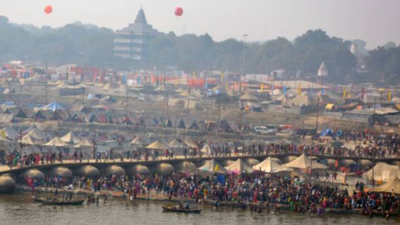Mauni Amavasya, also known as Maghi Amavasya, is a very significant day in the Hindu calendar. It is observed on the new moon day of the Magha month, which falls either in January or February. The word “Mauni” comes from “Mouna,” which means silence, and “Amavasya” means new moon. “Together, Mauni Amavasya represents a day focused on self-reflection, self-restraint, and spiritual rejuvenation.
The practice of silence on Mauni Amavasya is not just an antic; it holds deep philosophical meaning. According to Hindus, silence is a doorway to the divine. The absence of all external commotion is believed to allow the individual to listen to the soul, which implies introspection. This finally leads one to self-realization and inner peace.
The silence also reminds the devotees of the transience of the material world. By not speaking and being in the present, devotees feel a sense of detachment and spiritual freedom.
Mauni Amavasya date and timing
As per the Hindu calendar, Mauni Amavasya will fall on 28th of January 2025 at 7:35 PM and end on the 29th of January at 6:05 PM. Most people will follow the rituals on Wednesday, January 29.
Mauni Amavasya: Mythological significance
The tradition of observing Mauni Amavasya is rooted deep in ancient Indian scriptures and mythology. According to Hindu beliefs, this is when the Sun moves to the sign of Capricorn, known as Makara in Sanskrit, which marks an auspicious phase for spiritual practices. This period is part of the Kumbh Mela, especially in Prayagraj (formerly Allahabad), where the confluence of three holy rivers, Ganga, Yamuna, and the mythological Saraswati, attracts millions of devotees.
In Hindu mythology, Mauni Amavasya is related to the sacred rivers that are said to descend on this day. It is believed that a bath in these rivers on this day cleanses one of past sins and opens the way for salvation. The day is also related to the creation of the Universe. According to the Puranas, the Creator, Lord Brahma, started creating the world after meditation in silence on this day.
Mauni amavasya: Spiritual practices
1. Observing silence (Mauna Vrata)
The most distinctive feature of Mauni Amavasya is the observance of silence. The devotees take a vow of silence, called Mauna Vrata, to concentrate their energy within. This is not just a restraint on speech but also silencing the mind and attaining mental clarity. The silence enables the practitioners to introspect, meditate, and align their thoughts with higher spiritual goals.
2. Holy bathing (Snan)
On Mauni Amavasya, it is considered highly auspicious to take a dip in sacred rivers, especially at the Triveni Sangam in Prayagraj. It is said to purify the body, mind, and soul. According to the scriptures, taking a holy dip during the Magha month multiplies the benefits of this act and results in the accumulation of spiritual merit.
3. Charity (Daan)
On this Mauni Amavasya, charity activities are performed. People distribute clothes, food, and other important items to those in need. According to their belief, anything given on this day will attract prosperity, fulfill spiritual needs, and bring positive fortune. Important things to be donated are sesame seeds, ghee, and jaggery.
4. Worship and rituals
Rituals in honor of one’s ancestors (Pitru Tarpan) are performed by devotees on Mauni Amavasya. These oblations help satisfy the souls of the ancestral spirits and provide peace to their souls. Highly auspicious are worshiping Lord Vishnu, Lord Shiva, and Surya Dev or Sun God. Many keep a day-long fast and end it after sunset.
5. Astrological importance
Mauni Amavasya is important in Vedic astrology. The day brings the alignment of celestial bodies that create a type of atmosphere accommodating spiritual practice. According to the popular belief, it is said that the cosmic energies are high and that it would be a good time to start anything new or focus on the betterment of individuals.
Mauni Amavasya 2025 importance
During Kumbh Mela, one of the world’s largest religious congregations, Mauni Amavasya is highly renowned. On this day, the maximum number of pilgrims, saints, and seers participate in the fair. The ritualistic bathing at the Sangam is a glorious site, where millions of devotees gather for liberation.
Ascetics, particularly Naga Sadhus, play a significant role in the Kumbh Mela. The chants and rituals conducted by them from taking the rivers is a powerful highlight of the Kumbh Mela. Spiritual energy with collective devotion makes this event extraordinary.
Mauni Amavasya: Scientific importance
The practice of remaining silent is an exercise that has a scientific base to it, as it minimizes stress and calms the mind. Similar is the therapeutic effect of taking a bath in cold water. It helps circulate blood properly and enhances immunity. The rituals together with charity practices help bring the community together with compassion and promote harmony in society.
In today’s fast-paced world, the principles of Mauni Amavasya hold immense relevance. The practice of silence can help individuals disconnect from the chaos of daily life and focus on mindfulness. Similarly, the emphasis on charity and selflessness serves as a reminder to contribute to society and support those in need.
The environmental aspect of Mauni Amavasya is also quite noteworthy. This ritual bathing in the rivers features the streams in Indian culture. It is, in a way a call to protect and preserve the natural resources.
